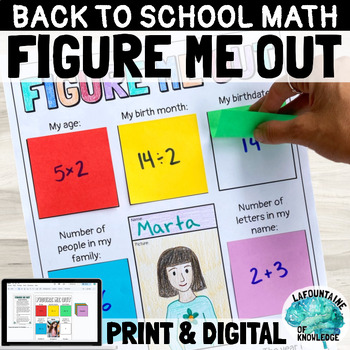Figure Me Out Back to School Math Activity PRINT and DIGITAL
- PDF
- Google Apps™

What educators are saying
Description
This "Figure Me Out" math activity is great for back to school and includes both print and digital versions. Students answer questions about themselves with numbers (example: how old are you, what year were you born, how many people are in your family, etc.) and then come up with math problems for each answer. They write their equations on sticky notes and place them over the answer (or type, drag and drop in the digital version.) Classmates then have a chance to solve the equations to learn more about each other (lifting the sticky notes to check their answers). This activity can be used for many grade levels.
This resource includes:
- Tips for teachers for both versions
- A force copy link to the Google Slides digital version of this project
- Student directions
- The blank "Figure Me Out" poster
- Examples (both print and digital)
- A scoring rubric
The printable poster is designed to be printed on 11 by 17 inch "ledger" paper. Check the preview file for a sneak peak!
Please follow my store here for more great resources!
You can also find me on Facebook, Instagram, and lafountaineofknowledge.com where you'll discover ideas, inspiration, and plenty of freebies! Or join my email list to get my monthly newsletter with exclusive FREE resources you can't get anywhere else!
Want free money to spend on Teachers Pay Teachers? Rate this product to earn some TpT credit! Leaving feedback helps us both out and takes less than a minute! Your support makes it possible for me to continue making and sharing great resources! Thank you!
Credits: Finished example photo and drawing by Shea LaFountaine of LaFountaine of Knowledge. Digital photo by Tawny Nina Botha, used with permission and sourced via Pixabay. Fonts used include Londrina Solid and Londrina Sketch by Marcelo Magalhães, Amatic SC by Vernon Adams, Pangolin by Kevin Burke, and Short Stack by James Grieshaber. All fonts were used with permission under open source licenses.





